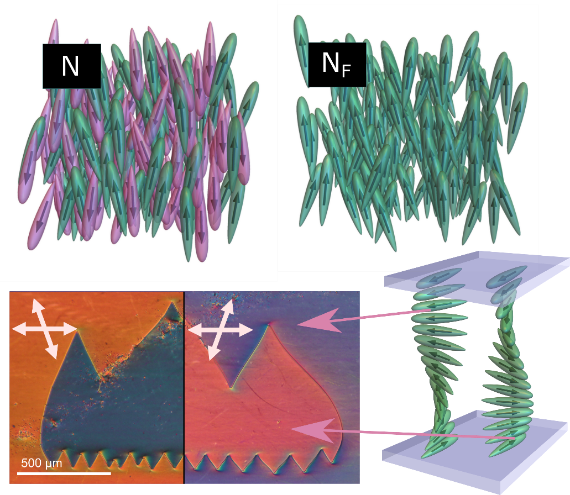Recently discovered ferroelectric nematic liquid crystals (FNLCs) are unique examples of liquid materials. Due to the combination of low symmetry, specific topology, and coupling between spontaneous polarization and nematic order parameter, they are very interesting for fundamental studies of distinct effects and topology of these complex liquids. Additionally, spontaneous polarization values of 0.05 As/m, large effective dielectric constant (>10000), and nonlinear optical coefficients (1-10 pV/m) in combination with nematic switchability make them very promising for applications, e.g., switchable elements in nonlinear optics or organic electronics. Their liquid nature manifests in unique ferroelectric domain structures of which integral parts are topological defects and for studies of the fundamental properties and exploitation of FNLCs in devices, precise and reproducible control of these structures is needed.
In this fundamental project, we plan to intertwine experimental and theoretical studies to achieve effective control over the creation and shape of ferroelectric domains and topological defects through an in-depth fundamental understanding of the system. We will exploit the original principle, which we proposed and demonstrated in our preliminary work, that in FNLCs, a deformation of the nematic orientation caused by inhomogeneous surface anchoring can be used to determine the orientation of the polarization. Our first aim is to identify and realize complex surface patterns that induce well-defined ferroelectric domain structures. Through continuous feedback between experimental and theoretical studies, we will develop a mesoscopic continuum model of the ferroelectric nematic phase and its interaction with the surface. The model will serve as the foundation for the design of more complex domain structures, for the realization of a variety of topological defects, and for the combination of theoretical and experimental studies of the response of the material to electric fields.
One of the biggest potentials of ferroelectric nematic liquids is their uniquely strong nonlinear optical response, for example, second harmonic generation (SHG). We will use SHG imaging for studies of domains and topological defects. Because the generation and propagation of SHG light in nonhomogeneous birefringent structures are complicated, we will develop a numerical tool for calculations of SHG images of nonhomogeneous structures with defects, which is currently unavailable but is essential for the future design of nonlinear optic elements.
A particular challenge is also the role of topology in such a system described by two fields (nematic tensor field and polarization vector field), which is known to be able to provide unifying insight into the material structure and material properties. We plan to construct a theoretical formalism for describing and classifying defects in ferroelectric nematic liquids. It will provide intuition about the phenomenological behavior of materials in different confinement conditions and serve as a base for interpreting experimental and numerical observations of defects. Furthermore, we will exploit the knowledge obtained throughout the realization of the initial project goals to generate and move topological defects by surface patterning and/or electric fields and, consequently, to achieve active control over domain structures.
The project will be realized by the members of the Light&Matter Group from Jožef Stefan Institute, who are experts in experimental studies of polar soft matter materials and were involved in the discovery and experimental studies of the ferroelectric nematic liquids, and theoretical physicists from the Group for the physics of soft and partially ordered matter at Faculty of Mathematics and Physics, University of Ljubljana who are experts in theoretical modeling of complex soft matter systems and their topology.

More details on SICRIS

The research project is (co)financed by the Slovenian Research and Innovation Agency.

